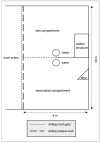Feathered Lectures-Evidence of Perceptual Factors on Social Learning in Kea Parrots (Nestor notabilis)
- PMID: 38891698
- PMCID: PMC11171027
- DOI: 10.3390/ani14111651
Feathered Lectures-Evidence of Perceptual Factors on Social Learning in Kea Parrots (Nestor notabilis)
Abstract
Social learning describes the acquisition of knowledge through observation of other individuals, and it is fundamental for the development of culture and traditions within human groups. Although previous studies suggest that Kea (Nestor notabilis) benefit from social learning, experimental evidence has been inconclusive, as in a recent two-action task, all perceptual factors were ignored. The present study attempts to address this by investigating social learning in Kea with a focus on social enhancement processes. In an experiment with a captive group of Kea, we investigated whether individuals that had the opportunity to observe a conspecific performing a simple task subsequently show better performance in that task than a control group without prior demonstration. This study provides a strong tendency of greater success in skill acquisition in Kea as a result of social learning. Kea that observed a conspecific solving a task showed clear evidence of perceptual factors drawing attention to the relevant parts of the experimental apparatus and manipulated these significantly more (100% of trials) than control birds (77.8% of trials). Combined with a strong trend (p = 0.056) of the test subjects solving the task more than the control subjects, this shows conclusively that Kea, at least when required to solve a task, do attend to perceptual factors of a demonstrated action.
Keywords: avian cognition; parrot behavior; parrot cognition; stimulus enhancement.
Conflict of interest statement
The authors declare no conflicts of interest. The funders had no role in the design of the study; in the collection, analyses, or interpretation of data; in the writing of the manuscript; or in the decision to publish the results.
Figures









Similar articles
-
Kea, bird of versatility. Kea parrots (Nestor notabilis) show high behavioural flexibility in solving a demonstrated sequence task.J Ornithol. 2024;165(1):49-55. doi: 10.1007/s10336-023-02127-y. Epub 2023 Dec 16. J Ornithol. 2024. PMID: 38225935 Free PMC article.
-
Kea (Nestor notabilis) fail a loose-string connectivity task.Sci Rep. 2021 Jul 29;11(1):15492. doi: 10.1038/s41598-021-94879-x. Sci Rep. 2021. PMID: 34326392 Free PMC article.
-
'Do I know you?' Categorizing individuals on the basis of familiarity in kea (Nestor notabilis).R Soc Open Sci. 2023 Jun 21;10(6):230228. doi: 10.1098/rsos.230228. eCollection 2023 Jun. R Soc Open Sci. 2023. PMID: 37351495 Free PMC article.
-
Technical intelligence in animals: the kea model.Anim Cogn. 2006 Oct;9(4):295-305. doi: 10.1007/s10071-006-0033-8. Epub 2006 Aug 15. Anim Cogn. 2006. PMID: 16909237 Review.
-
'Ghost' experiments and the dissection of social learning in humans and animals.Biol Rev Camb Philos Soc. 2010 Nov;85(4):685-701. doi: 10.1111/j.1469-185X.2010.00120.x. Biol Rev Camb Philos Soc. 2010. PMID: 20128784 Review.
Cited by
-
Study on the characteristics of head and neck movements of geese walking in a straight line at different speeds.Front Vet Sci. 2025 May 30;12:1554240. doi: 10.3389/fvets.2025.1554240. eCollection 2025. Front Vet Sci. 2025. PMID: 40520428 Free PMC article.
References
-
- Mathis A., Chivers D.P., Smith R.J.F. Cultural Transmission of Predator Recognition in Fishes: Intraspecific and Interspecific Learning. Anim. Behav. 1996;51:185–201. doi: 10.1006/anbe.1996.0016. - DOI
Grants and funding
LinkOut - more resources
Full Text Sources

